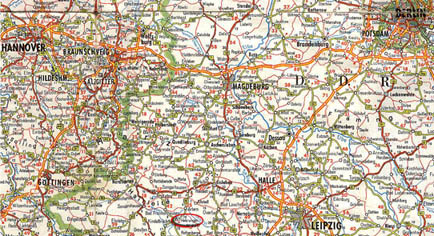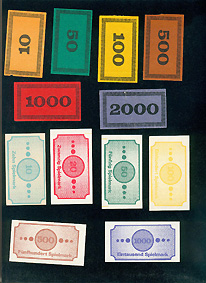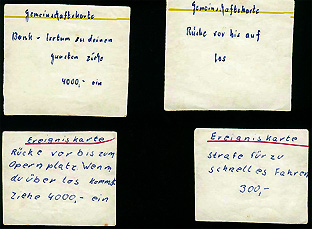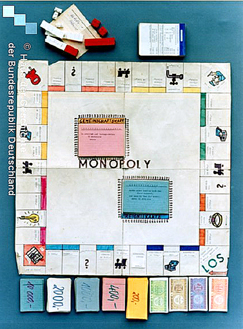|

|
Number of versions: 3
Edition: November 28, 2009
|

 Edition: Handmade
Monopoly of non exsisting city
Edition: Handmade
Monopoly of non exsisting city
Makers: Unknown Oberheldrungen (GDR) inhabitants - ±1980?
Owner: Rudolf Rühle - D.
The game:
Rudolf was able to buy this incomplete game from a seller of second hand articles in the eastern part of Berlin,
without
 dice,
tokens and rules. Only much in Eastern Germany produced play-money.
dice,
tokens and rules. Only much in Eastern Germany produced play-money.
This result of home industry was made before the
unification of E. and W. Germany in 1990.
It is a pity the makers are unknown, because I'd liked to ask them why they
had choosen for this mixture of property names. It must be said they must have had
good knowledge of the official capitalist version from the other side of the
Iron Curtain.
From Los onwards the properties are:
Poststraße - Gemeinschaftsfeld
- Turmstraße - Einkommenssteur - Palasthotel
- Oberbach - Ereignisfeld -
Unterbach
- Am alten Hafen - Nur zu Besuch - Waldstraße
- Elektrizitätswerk - Heldrungerstraße
- Eifelturm - Feldstraße
- Hotel Neptun - Münchnerstraße
- Gemeinschaftsfeld - Pariserstraße
- Humboldt Universität - Berlinerstraße -
Frei Parken - Dorfplatz - Ereignisfeld
- Rathauspassagen - Opernstraße
- Hotel Metropol - Goethestraße
- Wasserwerk - Lutherstraße - Müntzerstraße
- Gehen Sie in das Gefängnis - Am
Helderbach - Schiefer Turm von Pisa - Wallstraße
- Gemeinschaftsfeld - Mühlgasse - Hotel Stadt Berlin
- Fernsehturm - Karl-Marx-Allee -
Zusatzsteuer and Unter den Linden.
Remark that the "station spaces" in the middle of each side are now
hotels in Berlin.
 The board consits of 4 sheets (each 210 x 241 mm)
of thin white paper and is hand painted and written. The same symbol (a
question mark) is used for both the Ereignisfelder (Chance spaces)
as the Gemeinschaftsfelder (Community Chest spaces).
Most of the color bars are the same as on the Parker gameboards, but
situated differently.
The board consits of 4 sheets (each 210 x 241 mm)
of thin white paper and is hand painted and written. The same symbol (a
question mark) is used for both the Ereignisfelder (Chance spaces)
as the Gemeinschaftsfelder (Community Chest spaces).
Most of the color bars are the same as on the Parker gameboards, but
situated differently.
The "Go to prison" corner shows 2 arrows
pointing to opposite directions, meaning that you can go either way to
prison but in both cases you will not receive 4000.- Mark.
The sizes of the handmade property deeds vary slightly between 55/60 x
105/109 mm.
The sizes of Ereignis cards are 57/61 x 70/71 mm while for some unclear
reason those of the Gemeinschafts cards are somewhat larger: 69/70 x 76/78 mm.
Both cards have the usual texts and a few times newly invented ones. The
picture of the unequal Gemeinschafts cards, yellow
underlined, and Ereignis cards, red
underlined, show they are written by 2 different persons!
The money consists of an undifined mixture of grey pasteboard
game coins in the denominations of:1 - 5 - 10 and 20 (gold colored) and paper
bills from at least 3 different sources.
The tokens and dice of this set were absent.
I found that in the museum "Haus der Geschichte
der Bundesrepublik Deutschland" in Bonn-D also 2 handmade editions from
the former DDR are present.
Of the first mentioned, the one with the stacks Gemeinschaftskarte
and Ereigniskarte, the German magazine Spielbox,
Heft 5/95 from November/December 1995 shows a very good picture on page 6.
Unfortunately I got no response to my question to the museum for information
about and good pictures of these editions, so I can only point you to the
exsistance of these games and further recommend you to personally examine them in
Bonn, Willy-Brandt-Allee 14.
 Edition:
Handmade
Monopoly, copied from the board acc. to P.B. design
Edition:
Handmade
Monopoly, copied from the board acc. to P.B. design
Maker: Unknown - 1960/1985
Owner: Haus der Geschichte - Bonn - D
Dimensions of the board: 49.6 x 49.8 cm
The game:
The period in which the HDG states this game was made has been probably
concluded from the fact that this game board has been copied from a Parker Bros.
edition from this period, where: